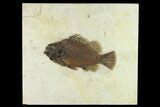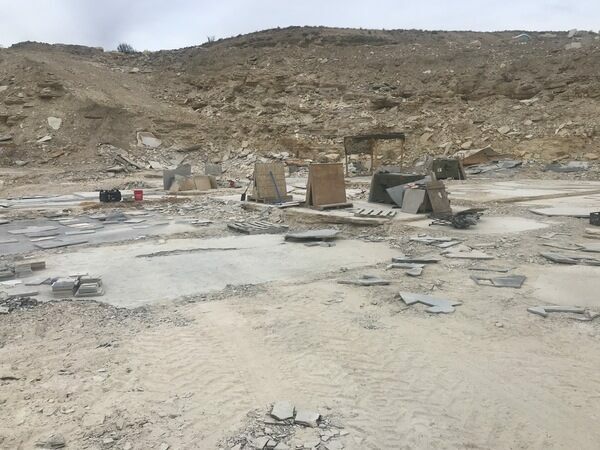This Specimen has been sold.
6.2" Fossil Fish (Priscacara) - Green River Formation, 18 Inch Layer
This is a nicely preserved 6.2" long Priscacara serrata fossil fish from the famous 18 inch layer of the Green River Formation. It was collected from Warfield's Quarry near Kemmerer, Wyoming. The preparation on it is excellent.
This specimen includes an acrylic display stand.
This specimen includes an acrylic display stand.
About Priscacara
Priscacara is an extinct genus of temperate bass that lived during the Eocene. It is an uncommon species in the Green River Formation, representing less than 1 percent of total fish fossils. It is a favorite among fossil collectors, particularly those specimens with all of their dorsal spines pointing upwards. It can occasionally reach impressive sizes in excess of 16 inches in length. Priscacara has a large mouth and impressive array of teeth can often be seen in detail on larger, well-preserved specimens.
Priscacara is more frequently found in shoreline lake deposits and less frequently found in rocks deposited in the center of the lake. Its appearance is very similar to that of Cockerellites, a genus of smaller schooling fish found in large numbers in the mid-lake quarries. Cockerellites maxed out in the 5 to 6-inch range, so specimens larger than that are assumed to be Priscacara. Cockerellites have more dorsal and anal fin rays than Priscacara and a significantly smaller mouth.
Priscacara is an extinct genus of temperate bass that lived during the Eocene. It is an uncommon species in the Green River Formation, representing less than 1 percent of total fish fossils. It is a favorite among fossil collectors, particularly those specimens with all of their dorsal spines pointing upwards. It can occasionally reach impressive sizes in excess of 16 inches in length. Priscacara has a large mouth and impressive array of teeth can often be seen in detail on larger, well-preserved specimens.
Priscacara is more frequently found in shoreline lake deposits and less frequently found in rocks deposited in the center of the lake. Its appearance is very similar to that of Cockerellites, a genus of smaller schooling fish found in large numbers in the mid-lake quarries. Cockerellites maxed out in the 5 to 6-inch range, so specimens larger than that are assumed to be Priscacara. Cockerellites have more dorsal and anal fin rays than Priscacara and a significantly smaller mouth.
About The 18 Inch Layer Of Fossil Lake
Specimens like this come from the coveted 18 inch layer of the Green River Formation, which produces darker and more detailed fish than the majority on the market. The rock from this layer is much harder and more durable than other layers in the formation, likely due to its initial deposition conditions in deep water. Because of these conditions, fish found in the 18-inch layer can be extracted whole and in excellent condition. This layer is typically collected at night using low-angle light to see the bump in the rock that the fish's backbone creates. They then cut these fish out and take them to a lab where the fish, which may be up to an inch under the surface of the rock, are meticulously extracted under microscope with hand tools.
Specimens like this come from the coveted 18 inch layer of the Green River Formation, which produces darker and more detailed fish than the majority on the market. The rock from this layer is much harder and more durable than other layers in the formation, likely due to its initial deposition conditions in deep water. Because of these conditions, fish found in the 18-inch layer can be extracted whole and in excellent condition. This layer is typically collected at night using low-angle light to see the bump in the rock that the fish's backbone creates. They then cut these fish out and take them to a lab where the fish, which may be up to an inch under the surface of the rock, are meticulously extracted under microscope with hand tools.
SPECIES
Priscacara serrata
LOCATION
Warfield's Quarry, Kemmerer, WY
FORMATION
Green River Formation
SIZE
6.2" long on 9.9 x 8.7" rock
CATEGORY
SUB CATEGORY
ITEM
#132870
We guarantee the authenticity of all of our specimens.
 Reviews
Reviews













